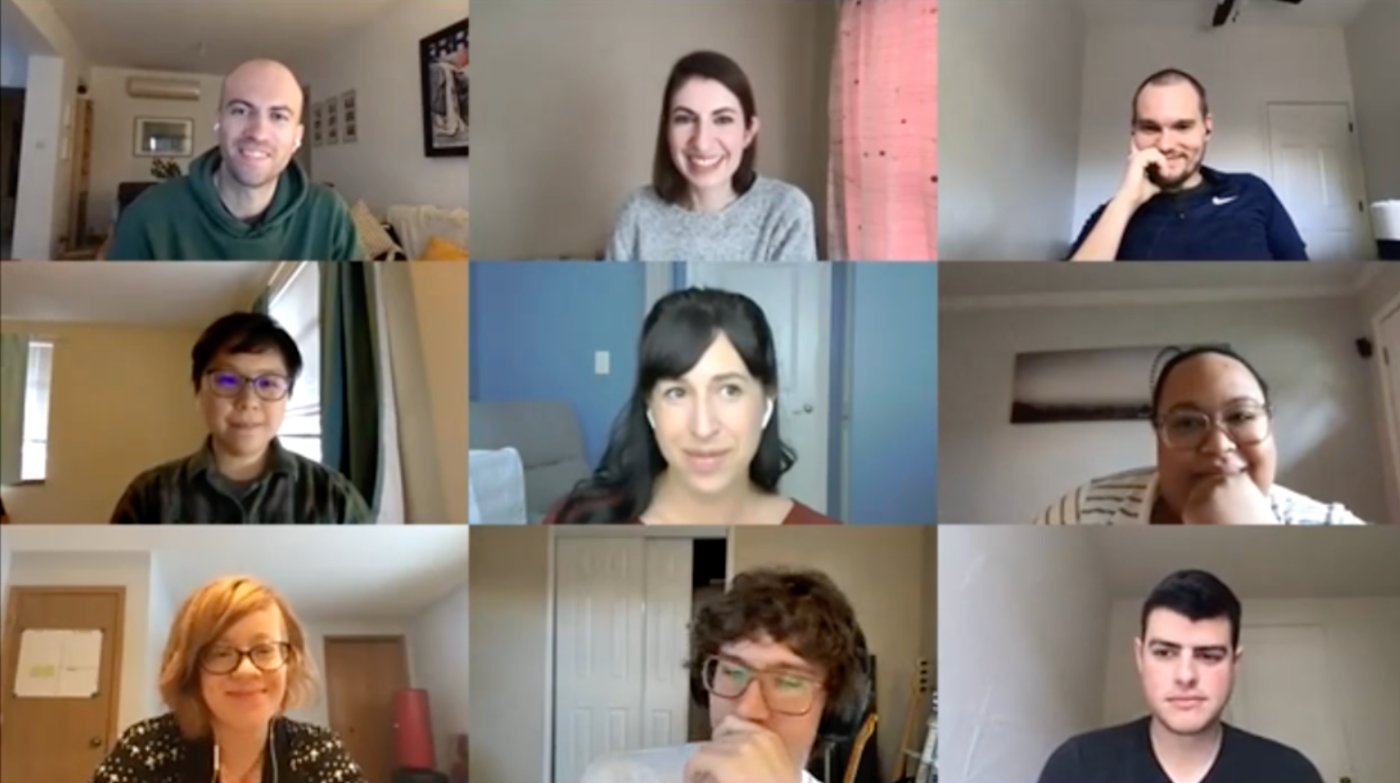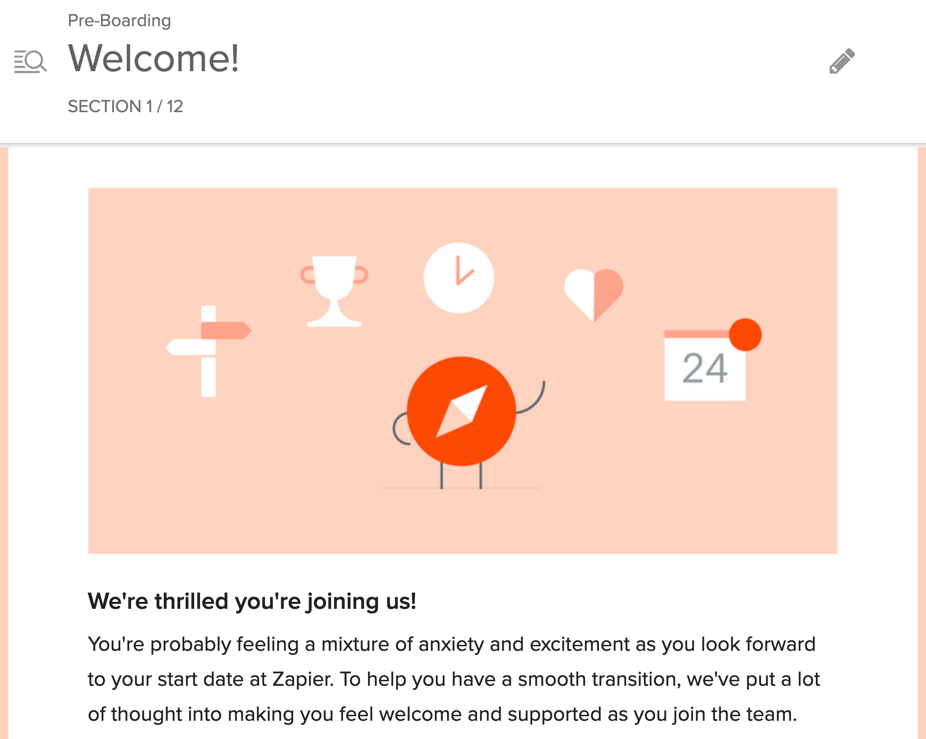A successful onboarding program is the first step toward employee satisfaction and productivity. But no matter how well you've streamlined your process, everything changes when you have to do it remotely. How do you make new team members feel supported and included when they've never seen any of their coworkers face-to-face? How do they get to know the company when they can't turn to the people around them to ask questions on the fly? How do you get them to feel comfortable sharing their real opinions on the pick for the newest Bachelor?
At Zapier, our onboarding is entirely remote. We use Sapling for asynchronous tasks and Zoom for live sessions. I did an interview with Sapling about how we do remote onboarding, and here I'll share some of the tips I gave them, along with a few more insights.
Whether you've been forced into training your employees remotely or you've chosen to take your team remote, this should help you tackle work-from-home onboarding in a way that works for your new hires and your company.
Before I dig in, a warning: there's no one right answer here. Every company will—and should—do onboarding differently. That's kind of the point: your onboarding should be unique to your organization. It should help your new employees understand your company and culture, and how you do that will depend on how your company functions.
Be intentional about community and culture
We have four pillars guiding our onboarding program at Zapier:
Connect to community and culture.
Highlight new hires' strengths to improve the company.
Learn through active practice.
Gain company-wide context.
For remote onboarding, I'd say #1 is the most important to be intentional about. It's a unique challenge to create a personal experience for a new hire when you can't bring them around the office to introduce them to people, and they can't get a vibe for the company culture just by watching what's going on around them.
In remote onboarding, you need to foster a sense of connection and belonging from the very beginning. There are a couple main ways we do this at Zapier:
1. Live sessions. Our live Zoom sessions, where a cohort of new teammates all get together, are crucial for building connections between our executives and crew members. These sessions are set up kind of like a class. We even use the Zoom breakout room feature to get people into small groups.

2. Make it personal. One of our live sessions is about bringing your whole self to work. In addition to making employees happier, more engaged, and more productive, the personal side of things helps folks feel more comfortable in a situation where it would be harder to really get to know each other. At Zapier, we design our onboarding prompts and questions to draw out stories about people's strengths and what it means to them to bring their authentic self to our organization.
If your company is big enough, you can create a sense of belonging and inclusivity in your onboarding by having new hires start with a crew of other people. If you approach your onboarding that way, make sure you have time for intros, bonding, and breakout sessions on Zoom and Slack. Cohorts become friends, and when we get together in person, we see people from our onboarding crews hanging out together and showing a genuine sense of pride about where they work.
Give everyone a buddy
This isn't summer camp—we get that. But giving everyone a "work buddy" of sorts can at least guarantee that each new hire has someone they can go to with personal questions or anything they don't feel like talking to their manager or close colleagues about.
At Zapier, we call this the "Zap Pal" program. Every new hire is assigned a Zap Pal, who reaches out to them in their first week, sets up at least one Zoom call with them, and continues to check in throughout their first month or so. It gives everyone a guaranteed 1:1 relationship, which is so important when you're spending most of your time alone in your house.
Plus, there's a bonus for the company: it can bring about cross-functional ideas. You're getting people who might not normally interact to chat, and you never know what will come from that.
Don't be afraid to be asynchronous
So live sessions and face-to-face connections are crucial—no question about that. But if you're a remote company, or will even be remote for some amount of time, you need your new hires to get used to asynchronous work. The best way to do that: have some asynchronous onboarding.
We use Lessonly to build self-paced lessons for each new hire, and Sapling, our onboarding platform, helps us automatically deliver content.

Our asynchronous onboarding runs the gamut from digesting written content to completing interactive tasks. Here are some examples:
All the fundamentals (things like core values, HR processes, and so on) are assigned as readings in Lessonly.
We ask new hires to draw or write down answers to questions that will help them think more deeply about Zapier and their new roles.
We've even set up asynchronous scavenger hunts, which encourage new hires to find information (and people!) throughout the company at their own pace.
A balance of asynchronous and live onboarding will give everyone a chance to meet and connect, while also introducing them to the asynchronous way of working remotely—and giving them lots of links they can revisit later.
Some onboarding workflows can involve over 100 steps. That can be overwhelming to a new hire. So when you are building out your onboarding program, delivering small bits of digestible information over a longer period of time can go a long way.
Check in early and often
It's good to be intentional with any onboarding program, but intentionality is particularly important when building a distributed team. With on-site onboarding, you can visually see how your new hires are doing. It's easier to tell if they're falling behind or even if they're just struggling emotionally.
In a distributed team, it's helpful to check in more often with folks to make sure they're progressing at the right pace. It might feel like you're micromanaging, but better that than the opposite: having a new hire fall behind or feel out of the loop.
Remember: the check-ins don't have to come from the same person all the time. Between the onboarding team, their manager, their company buddy—there are plenty of people who can be sure everything's on track.
Ask for feedback
Especially if it's your first time onboarding remote employees, ask for feedback. At Zapier, we use surveys as well as looking at Sapling completion data to see how things are going.
Not everyone will benefit from the same exact things—and that's okay. But you might find that there are certain things that aren't working for anyone. If that's the case, cut them. There's certain information you have to deliver, but there's no set-in-stone way you have to deliver it. Our surveys, for example, revealed lots of requests for more interactivity, so we listened and adapted.
Make sure your onboarding program is iterative and takes into consideration the feelings of your team members, and you'll foster a sense of belonging long after onboarding is completed.





